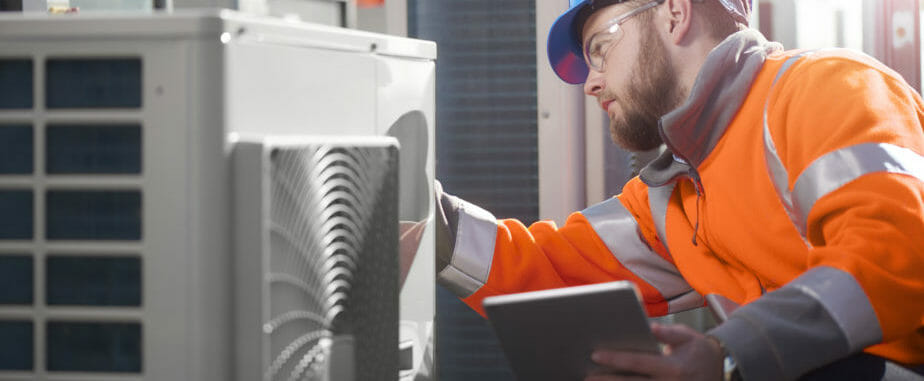Property managers and building owners have a responsibility to keep the occupants and visitors in their building safe at all times. That responsibility can be complicated when roofing teams are onsite to conduct repairs or to replace the roof system. Roof repair and re-roofing projects can be dangerous work, with many potential hazards for anyone in and around the property. Before any work begins, it is necessary to have some serious discussions about safety.
The Contractor’s Responsibility For On-Site Roofing Safety
The roofing contractor should submit a Job Hazard Analysis (JHA) well in advance of the project start date. This is not required by law, but more building owners are starting to request it and many contractors submit a JHA as a matter of course.
A JHA requires supervisory teams to survey the project and essentially answer the question, “What are the things that could go wrong?” The JHA should address hazards not only to the roofing crew but to the people inside the building, visitors, and passers-by. It should address job safety issues like electricity, fall hazards, and dropped object hazards and should include the remedies that will be executed for mitigating those hazards.
Ideally, the JHA should be revisited and resubmitted on a weekly basis to ensure that supervisors are continuously evaluating the conditions on and around the roof. This serves as a checklist for the crew and the property manager, to ensure a system of checks and balances throughout the project.
How A JHA Should Work For You 1,2
Roofing contractors all take a unique approach to their JHAs, however, an ideal analysis and plan should look similar to this:
Prior To Starting Work:
- Crews will block off trucks and heavy equipment with safety cones.
- Necessary staging areas will be blocked off to foot and vehicular traffic.
- Verbal communication will be given to the front desk/reception area that work is beginning and caution should be taken.
- Signage/caution tape placed in visible areas to alert people entering and exiting the building to be aware of their surroundings.
- Restricted areas will be blocked off to passers-by and building occupants.
- A verbal and written notice will be given of potential fumes, noise, and heating/cooling system shutdowns.
- All equipment will be inspected according to safety protocol.
- All staff will wear the necessary protective headgear, footwear, gloves, etc.
Fall Protection
- The roof will be inspected for slip hazards, and protective measures taken to avoid contact with those areas.
- The area beneath the roof will be inspected for hazards that could cause impalement.
- Work will be suspended if weather conditions prevent safe working conditions (high winds, rain, snow, etc.). Work will resume when conditions allow.
- Holes, skylights, and other fall-through hazards will be identified and protective measures taken to avoid contact with unsafe footing conditions.
- Supplies will not be stored within x feet of roof edge.
- Warning lines will be installed y feet from edge of roof.
- Safety lines and anchorage points will support z lbs. of weight.
Work Safety
- Buckets containing hot liquid will not be carried up ladders.
- Buckets will not be filled more than x inches from the rim.
- Pathways will be kept clear of debris.
- Screws, staples, nails, and other small hazards will be picked up along the way.
- Any item that could blow away or roll off the roof will be secured.
- A full cleaning of the site will be conducted after every shift to remove hazards that could blow away.
- Tools will be secured to scaffolding, cherry pickers, etc.
Injury Plans
- Any worker who sustains an injury will report the incident to his or her supervisor immediately.
- Serious injuries may require assistance from emergency services.
A Property Manager’s Responsibility for On-Site Roofing Safety
Even the most safety-conscious roofer is no match for a tenant who ignores or is not aware of their surroundings. Property managers should arm the people entering and leaving the building with as much information as possible so that they can remain alert and aware.
As soon as a roofing project is scheduled, tenants and employees should be alerted to the impending project. This may involve signage, meetings with business owners, memos, or any variety of communication methods. These communications should address:
- Project start date and estimated time to completion.
- Hours of the day in which workers will be on-site.
- Lay-down areas for construction vehicles, ladders, scaffolding, etc.
- Projected noise, dust, and fume hazards and the steps the roofer will take to manage them.
- Posting of any changing parking, driving, or traffic patterns around the building.
- Areas of the building that may be access-restricted during construction (specific elevators, stairwells, floors, etc.).
- Procedures for reporting any injuries that are a direct result of the construction (trips, falls, traffic accidents with a construction vehicle, etc.).
Working Together To Ensure Overall Safety
Any pre-construction meeting with the contractor, property manager, and building owner should include a discussion about safety. Ideally, a tenant representative or representatives will be included, as well. The JHA may be reviewed, and safety protocols and procedures should be addressed. At the end of the meeting, everyone should have a handle on his or her own responsibilities for ensuring safety and for proper reporting of any incidents that may happen on-site.
Roofing projects are extremely hazardous to the crew and those in and around the building. However, with proper attention and commitment to on-site roofing safety, the risks and hazards can be minimized.

